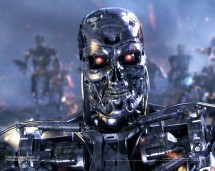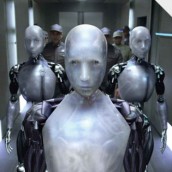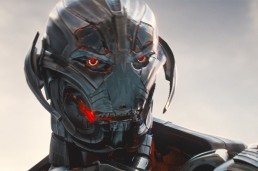Recently I was explaining to a friend the theme of my blogs on this site, and she recommended the movie “Her” by Spike Jonze. I expected to find a yet another cheesy Hollywood robot story, however I was pleasantly surprised by the ideas it challenged, as well as how well it related to my other writings.

This movie centralizes around a lonely author named Theodore, who recently went through a divorce. He buys a new, artificially intelligent computer operating system named Samantha to help him organize his life. Although it starts off as completely business, the two start to realize that they are falling in love.



I found this movie interesting for many reasons, however the main aspect was its unconventional portrayal of technology. Normally technology, or robots to be more specific, is seen in the film industry as an evil figure. There are hundreds, if not thousands, of cheesy sci-fi movies about intelligent computers rising up and taking over their human creators. Robots are usually seen as cold, emotionless, beings that evoke fear. “Her” challenges all of these stigmas. It presents the possibility of a both super-intelligent and humanoid computer. Samantha is given a name, a human voice full of emotion, feelings, and thoughts. Through these means the viewer is truly able to connect to her as if she were an actual person.
Another reason I find this movie so appealing is because of its presentation of radical ideas. While the story of a person falling in love with a robot is nothing new, “Her” puts a revolutionary, new spin on the idea, making it seem more relatable than ever. During the movie Samantha appears more as a person talking behind a curtain as opposed to a machine. She shares her feelings, shouts when she is angry, sighs when she is frustrated, and is prone to jealousy. With all these human features, where does one draw the line on acceptable robot-human interaction?
It is interesting to ponder the idea of a world in which we might one day see a struggle for equality not among homosexual couples, but rather robot-human couples. As the plot of the movie thickens, it is revealed that many people in society, not only Theodore, have become romantic partners with their operating systems. This poses the question of whether a person can truly love a robot, and how their relationship would play out. During the movie Theodore and Samantha appear almost as any “normal” couple. They talk about their feelings, share secrets, and express their desires. On many occasions her and Theodore end up in an argument that seems as real as that of any human pair, and at one point they even have a form of verbal sex. The reoccurring theme keeps coming up however of Samantha’s lack of a body. She struggles to feel adequate among other human figures in Theodore’s life.
With this movie comes many questions. Can this ever be a real possibility? If so, how will society view these types of relationships? These are questions that we could very well find out in the near future.
Sources/Images:
- http://www.thecover3.com/2014/01/The-Best-Films-Of-2013.html
- http://cdn.thedailybeast.com/content/dailybeast/articles/2015/05/10/fear-of-an-ai-planet-what-age-of-ultron-and-ex-machina-get-wrong-about-our-robot-overlords/jcr:content/body/inlineimage.img.800.jpg/47707382.cached.jpg
- http://c7.nrostatic.com/sites/default/files/uploaded/terminator.jpg
- http://www.popsci.com/sites/popsci.com/files/styles/medium_1x_/public/import/2013/images/2005/06/sci0804irobot_A.jpg?itok=K3Y7-G_v
February 24, 2016 at 10:20 pm
Wow! That’s amazing! I will watch the movie as soon as possible! I’m really curious! 🙂 A human-robot couple sounds like a strange possibility but you are right: why not? That’s always the most important question, maybe the only important one. If we substitute the adjective „natural” with the adjective „cultural“ we can have a lot of possibilities and I think that literature and cinema are perfect ways to represent new situations in uncommon contexts… It makes possible the impossible.
LikeLike
March 2, 2016 at 5:18 pm
(SPOILER ALERT) I thought this was a good review about the movie, and you’re right about what you say. I feel like the movie also tackles other topics about love and romance, such as when Theo finds out that she is also in a relationship with thousands of other humans across the world. For example, without saying it, I feel like they bring up the topic of polyamory because the convo is something like this:
Samantha: “This doesn’t make me love you any less, it actually makes me love you more.”
Theo: “That doesn’t make any sense, you’re mine or you’re not mine.”
Samantha: “No, Theodore, I’m yours and I’m not yours.”
Really good job with this Aaron!
LikeLike
March 18, 2016 at 5:02 pm
Hi Aaron,
I find your article and your topic in general very interesting. It raises many questions that might really will be answered in near future.
Another movie that tells an interesting story about human-robot relationship is “Ex-Machina”. Although it ends (like you said) with the portrayal of robots as kind of “bad”, it also deals with the topics of isolation, emotions and exploitation by humans.
Like you said, the “question of whether a person can truly love a robot” is very interesting and I think what is even more interesting is the question of whether a robot can truly love a person? How can we know if this love is “true”? How can we measure love and its origin?
And another interesting question you brought up is: Would we allow this type of love or would we forbid it because it wouldn´t fit in our cultural and moral system……or would it fit in because WE created this love attachment?
Your article really makes me rethink many concepts of human life. So, well done 🙂
LikeLike
November 17, 2016 at 12:53 pm
Another movie that came to my mind while reading your post is “Chappie”. It tells the story of the first robot with a consciousness and features the duo “Die Antwoord”. It’s fun to watch but also makes you think about the consequences of such a scenario.
http://www.imdb.com/title/tt1823672/
LikeLike